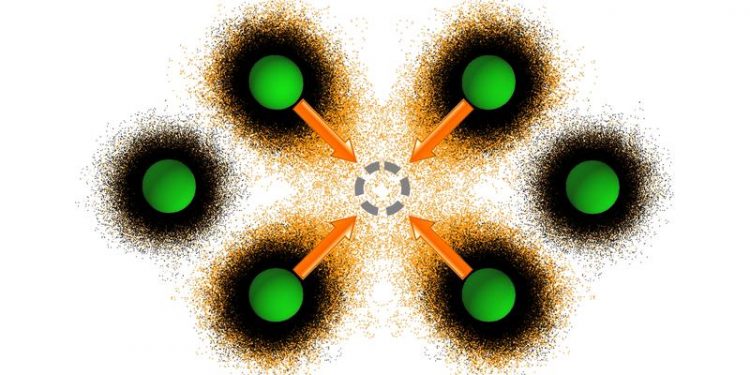Computer made materials

The picture shows the distribution of atoms next to a defect in a copper crystal at its melting point (1084° C). The green spots show the positions of the atoms at the absolute zero point. The dashed grey circle in the middle shows a lattice vacancy, a place where one atom is missing in the lattice. At high temperatures the atoms vibrate around their lattice position, illustrated by the black cloud. The results of the Max Planck scientists show a significantly different distribution (orange clouds) by considering the interaction of lattice vibrations. The atoms vibrate closer to the vacancy with increasing temperatures. This leads to a change in energies and vacancies and thereby to a higher defect concentration.
Point defects, for example missing atoms (so called vacancies) significantly influence the performance and durability of modern materials. Even smallest defect concentrations of 1:100,000 can affect the properties of microelectronic devices like processors, solar cells and structural materials like steel.
Matter is made out of atoms, which form in the case of crystalline materials a highly ordered lattice. However, the individual atoms do not sit motionless on their lattice sites, but vibrate with an extremely high frequency around their positions – scientists therefore speak about lattice vibrations.
To analyse the concentration of defects in a material and draw conclusions about the materials behaviour, there were until now two possible strategies: Theoretical physicists calculated the energy of the lattice-defect formation, which is directly linked to the number of defects, but their methods were limited to the absolute zero point, i.e. to -273.15 °C.
Experimentalists, on the other hand, measured defect concentrations at high temperatures (above 300 °C). In fact, there was always a large temperature range without available data. As a matter of fact, it is exactly this range around room temperature that is important for materials that are used in our everyday life.
Physicists in the department ‘Computational Materials Design’ at the Max-Planck-Institut für Eisenforschung (MPIE) now achieved a breakthrough in the development of computer simulations that are also able to describe this missing temperature range.
“Established methods for the energetics of lattices were previously not able to include the complex interaction of different modes of lattice vibrations. Thanks to various methodical breakthroughs, we are now able to remove this shortcoming for all relevant temperatures. And we were surprized to see how significantly these temperature-dependent interactions influence the amount of defects in a material”, explains Albert Glensk, doctoral student at the MPIE.
“Formerly predicted results for defects in crystalline materials have to be corrected now. Our calculations show that actual defect energies might easily be about 20% lower than previous estimates. More importantly, we are now for the first time able to close the gap between theory and experiment. All experimental data can be perfectly described with our theory”, concludes Glensk.
With these new insights, scientists are able to calculate and predict precisely how many point defects a material has at a certain temperature and derive conclusions about the performance of a material. This serves as an additional corner stone for the optimization of basic materials on the computer and the prediction of their potential failures as well as strategies to avoid them in production processes.
Original publication:
A. Glensk; B. Grabowski; T. Hickel; J. Neugebauer: Breakdown of the Arrhenius Law in Describing Vacancy Formation Energies: The Im-portance of Local Anharmonicity Revealed by Ab initio Thermody-namics. Physical Review X 4 (2014) 011018. American Physical So-ciety.
DOI: 10.1103/PhysRevX.4.011018
http://www.mpie.de
http://journals.aps.org/prx/edannounce/PhysRevX.4.010001
Media Contact
All latest news from the category: Physics and Astronomy
This area deals with the fundamental laws and building blocks of nature and how they interact, the properties and the behavior of matter, and research into space and time and their structures.
innovations-report provides in-depth reports and articles on subjects such as astrophysics, laser technologies, nuclear, quantum, particle and solid-state physics, nanotechnologies, planetary research and findings (Mars, Venus) and developments related to the Hubble Telescope.
Newest articles

A new look at the consequences of light pollution
GAME 2024 begins its experiments in eight countries. Can artificial light at night harm marine algae and impair their important functions for coastal ecosystems? This year’s project of the training…

Silicon Carbide Innovation Alliance to drive industrial-scale semiconductor work
Known for its ability to withstand extreme environments and high voltages, silicon carbide (SiC) is a semiconducting material made up of silicon and carbon atoms arranged into crystals that is…

New SPECT/CT technique shows impressive biomarker identification
…offers increased access for prostate cancer patients. A novel SPECT/CT acquisition method can accurately detect radiopharmaceutical biodistribution in a convenient manner for prostate cancer patients, opening the door for more…





















